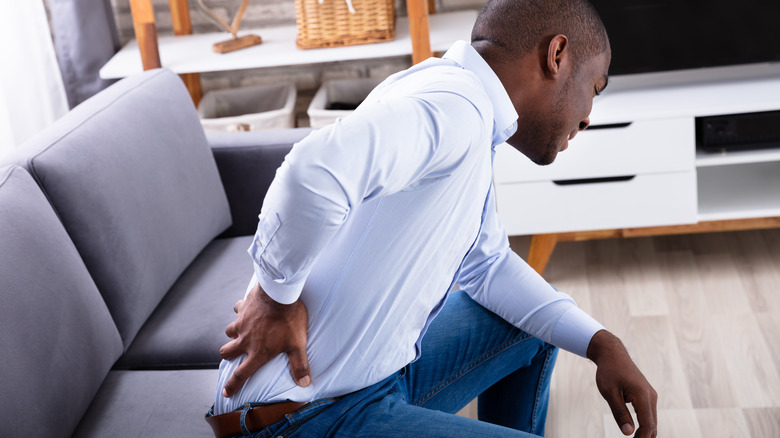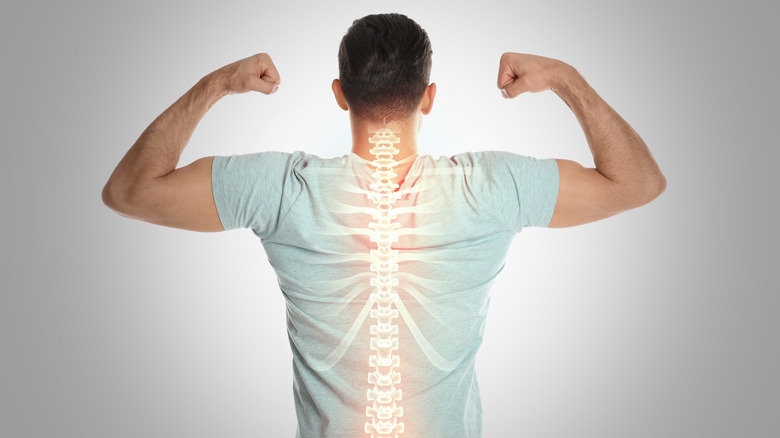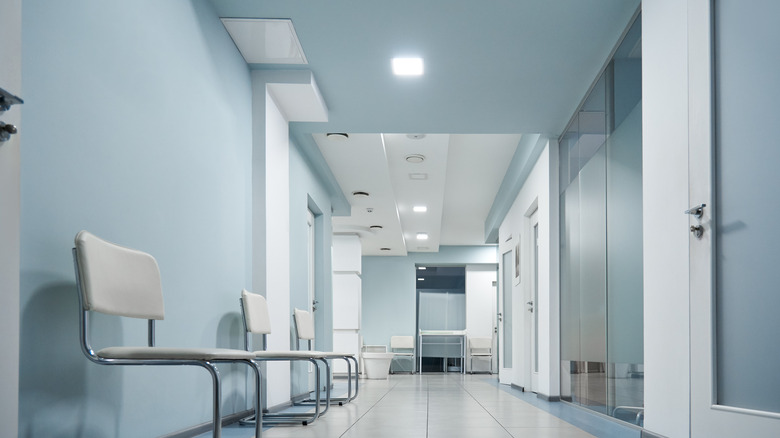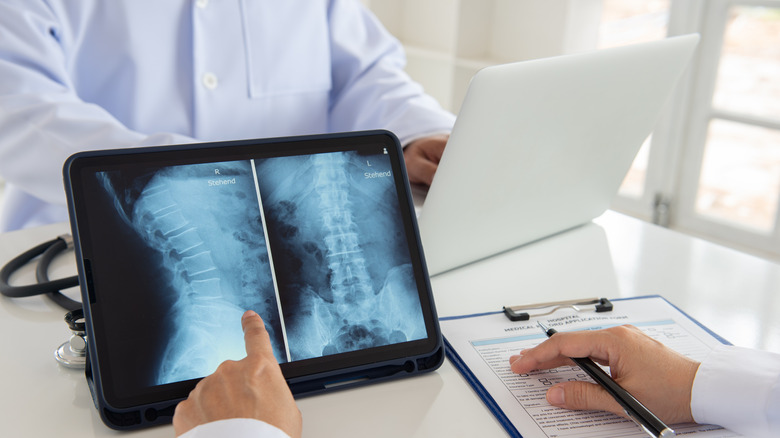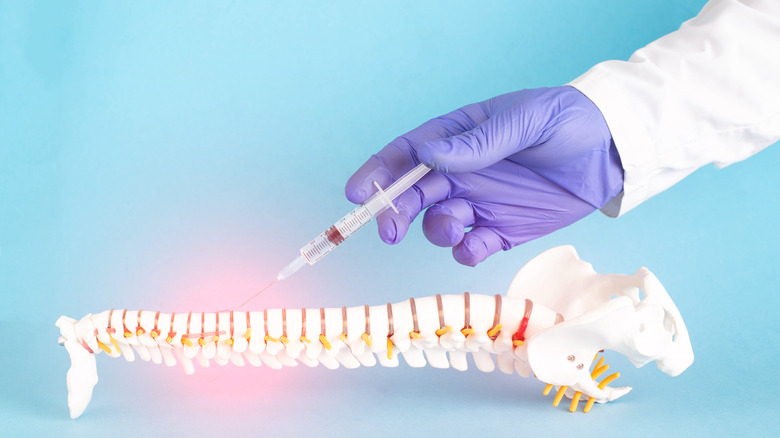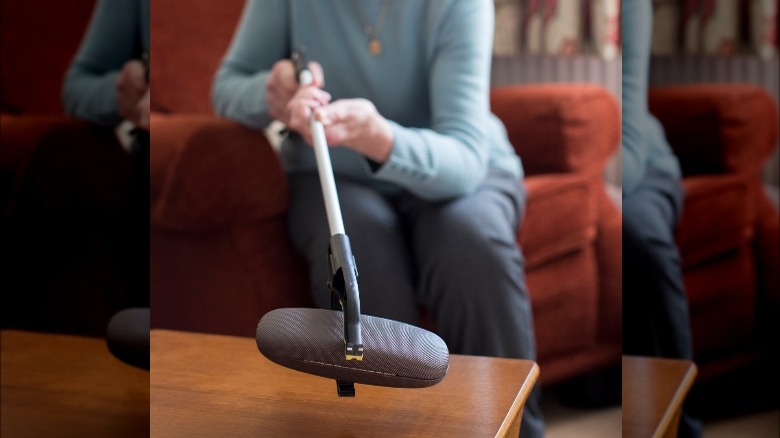Back Pain Explained: Causes, Symptoms, And Treatments
There's a solid chance you know someone who is struggling with back pain right now. According to the American Chiropractic Association, 50% of all working Americans admit to having back symptoms each year, and 80% of the population will experience back pain at some point during their life. Back pain can have a significant impact on your quality of life. Chronic back pain is scientifically linked to trouble performing daily activities, disability, unemployment, psychological problems, and drug abuse, according to a 2018 study in Health and Quality of Life Outcomes. Additionally, a 2019 study found that younger people struggle more to maintain their quality of life when in pain, possibly because older people consider pain a "normal" part of the aging process (via Oxford Academic).
Whatever your reason for back pain, you may want to know more about this incredibly common condition. Let's take a look at some of the causes, symptoms, and treatments.
Causes of back pain
It's helpful to understand that the back is one of the most complex parts of your body; it comprises muscles, ligaments, tendons, disks, and bones. Weill Cornell Medicine specifies that the regions of the back and spine are separated into multiple regions: cervical, thoracic, and lumbar. The cervical region includes the vertebrae of the neck, the thoracic region encompasses the vertebrae of the upper back, and the lumbar region refers to the lower back.
Cervical and lumbar pain are more common than thoracic pain because the middle of the spine is the least flexible section. This is why the Weill Cornell website explains that the middle and upper back pain can "often be a sign of something other than muscle stress" and typically requires more investigation. Unfortunately, the spine is similar to a row of dominos — if one thing goes wrong, it can trigger a slew of other problems.
Most back problems are related to strain or overuse, such as muscle spasms and tension and pain resulting from an injury, fracture, or fall (via Medical News Today). Sometimes, structural problems cause pain, and these can be a little trickier to treat. Examples of structural problems include ruptured or bulging disks, osteoarthritis, sciatica (nerve pain), an abnormal curvature of the spine, or osteoporosis. Occasionally, pain is caused by other health concerns such as kidney problems, cancer, or infection.
Your job, lifestyle, and hobbies are all risk factors
According to a study in Health and Quality of Life Outcomes, "Female gender, older age, lower education, manual labor occupation, and population density were significantly associated with the distribution of chronic back pain."
The National Institute of Neurological Disorders and Stroke (NIH) explained that a person's first bout with back pain usually occurs between the ages of 30 and 50. As we age, the chances are high that we will experience some pain due to a combination of lost bone strength and decreased muscle elasticity and tone. Additionally, the intervertebral discs become dry and stiff with age, reducing their ability to cushion our vertebrae.
The importance of fitness in preventing back pain can't be overemphasized. "'Weekend warriors' — people who go out and exercise a lot after being inactive all week — are more likely to suffer painful back injuries than people who make moderate physical activity a daily habit," the NIH revealed. Regular exercise also helps to keep excess weight off, which is important because those extra pounds can stress the back's integrity.
In addition to inactivity, smoking is another habit to steer clear of. It restricts blood and oxygen to the discs and causes them to degenerate faster than they otherwise would. According to Harvard Health, smoking damages blood vessels that transport nutrients to the spine. The importance of this is illustrated by the fact that in the United States, 36.9% of current smokers report back pain compared with 23.5% of never-smokers.
Sometimes back pain is an emergency
If you've ever had severe pain, it can be a very scary experience. According to Veritas Health, signs of a potential medical emergency include the sudden loss of sensation to either or both legs, genital area, the groin, or the anal region. You should go to the emergency room or call 911 if you cannot walk or stand, lose control of your bowel or bladder, experience difficulty passing urine, or develop "sudden, intolerable pain" in the lower back or legs.
Always get checked out in the emergency room if your back pain results from trauma or if you have osteoporosis and suspect a bone fracture. If you can't get in to see your regular doctor within a week, consider going to the urgent care if: you are also suffering from nausea or vomiting, over-the-counter medications aren't working, the back pain is radiating to your hip or leg, or your back pain is severe when you move in certain ways such as coughing or bending forward or backward. Additionally, Mayo Clinic adds that you should seek emergency care if a fever accompanies your back pain.
Diagnosing the problem is often difficult
Determining the severity of your back pain is pretty easy. It revolves around a physical exam, during which your doctor will assess your range of motion, reflexes and leg strength, and your ability to detect sensations in your legs. Your doctor will also want to examine your ability to walk and stand (via Healthline). Unfortunately, determining the cause of your back pain is much more difficult and can be a frustrating and lengthy process.
Many doctors will start with blood and urine tests to check for infections and other conditions responsible for your discomfort. If those come back clear, your doctor might order X-rays to check your bones for fractures or other obvious deformities. If X-rays don't make the diagnosis clear, your doctor may order a computed tomography (CT) or magnetic resonance imaging (MRI). Occasionally, bone scans are ordered.
Depending on your specific symptoms, your doctor may want to do electromyography (EMG). Johns Hopkins explains that an EMG "measures muscle response or electrical activity in response to a nerve's stimulation of the muscle" when neuromuscular abnormalities are suspected.
You can help to prevent another episode
Despite our best efforts, most of us will experience repeated episodes of back pain; more than two-thirds of individuals will have another episode of pain within a year of recovering from a previous bout of back pain, according to a 2019 study published in the Journal of Physiotherapy. You are more likely to experience pain again if you sit a lot, work bent over or with otherwise poor posture, or have had several previous episodes. Still, there is hope.
The U.S. Department of Health and Human Services explains that by doing back-strengthening and stretching exercises at least twice a week, avoiding heavy lifting and using good technique (bending at the knees), and taking care with your diet and losing weight if necessary, you can greatly reduce the chances or severity of future episodes. The Mayo Clinic explains that maneuvering heavy objects, repeating the same movements over and over (especially those involving "twisting or rotation" of the spine), and sitting for long periods are especially detrimental.
Over-the-counter and prescription medications can help
There are many proven ways to treat back pain (via MedlinePlus) Most everyone has used over-the-counter pain relievers such as Tylenol or Advil before. Narcotic pain relievers (also referred to as opioids) are used for severe pain and should not be used for longer than a few weeks because they carry a risk of overdose or addiction. Side effects of narcotics, such as oxycodone or tramadol, include impaired judgment, respiratory depression, and sleepiness.
Depending on your symptoms, muscle relaxants might be an option for you. Like narcotics, muscle relaxants should only be used for a short period because they can also be habit-forming. Low doses of antidepressants have proven useful in treating chronic low back pain, even among individuals who do not feel depressed. Lastly, anti-seizure or anticonvulsant medicines are especially useful for pain caused by nerve damage.
If you or anyone you know is struggling with addiction issues, help is available. Visit the Substance Abuse and Mental Health Services Administration website or contact SAMHSA's National Helpline at 1-800-662-HELP (4357).
If oral medications don't work, injections might be offered
Local anesthetics, steroids, and Botox can be injected into painful areas to cut down on painful inflammation, according to a report published on InformedHealth.org. OrthoInfo explained that epidural injections are typically used to treat pain that starts in the spine and expands to an arm or leg. Epidural injections, often of steroids, can be used to determine which nerve is causing your pain.
Facet joint injections, often used in the space between vertebra are often used for degenerative disc disease or arthritis. Similarly, sacroiliac (SI) joint injections are used to reduce the inflammation in the joints between the low back and pelvis. Problems in this part of the body can cause referred pain in the low back, buttock, and leg. A steroid can be used to reduce the inflammation causing these painful symptoms.
Verywell Health details the selective nerve root blocks often considered for patients with pain emanating from damaged nerve roots. These types of injections are useful when medical professionals are unable to determine the precise problem causing pain or if the pain could be coming from several different spinal areas.
Physical therapy and exercise are imperative
Many pros consider physical therapy to be one of the most critical parts of back pain treatment. According to Penn Medicine, aerobic activity is one of the most important types of activity for relieving back pain. A physical therapist can help you to find the exercises that are right for your specific health concerns. For example, many people need to avoid any exercises or activities that involve bending forward at the waist or twisting early in the morning until their spine has had time to wake up.
Cleveland Clinic detailed a few types of physical therapy: repeated motion, stabilization, and mobilization. Repeated motion is helpful for those dealing with common disc herniations or spinal stenosis; these conditions often lead to painful nerve impingement and cause symptoms in the legs. On the other hand, stabilization exercises might be the best choice for those whose job calls for awkward body mechanics and who have increased pain with certain postures or movements. People with an inflexible spine might benefit from exercises meant to stretch tight areas and improve range of motion, known as mobilization.
Alternative treatments show some success
Alternative practices are useful for the many people dealing with chronic pain, according to Johns Hopkins. For example, several studies determined that acupuncture may be a useful natural alternative in the treatment of back pain (via Medical News Today). Additionally, a 2016 study published in JAMA showed that training in yoga, mindfulness, and meditation provided significant improvement in more than half of participants who had experienced back pain for an average of 7.3 years. On the other hand, "usual care" improved 44.1% of the control group's pain scores.
Tai chi, a fluid movement therapy emphasizing slow and thoughtful exercises, may be especially helpful to people with back pain because it can "[strengthen] the muscles in the abdomen and pelvic areas that help support the lower back, [improve] balance and flexibility, [and increase] awareness of posture when sitting, standing and walking," according to the Arthritis Foundation. Tai-chi also helps to allay symptoms brought on by stress and improves sleep, both of which are a boon for pain relief.
Lastly, biofeedback trains people to recognize triggers for physical reactions in their body, such as learning to mark the balance between emotional reactions and pain, so that they can halt physical symptoms before they begin, according to a study in Mental Health in Family Medicine.
Surgery is usually the last resort
Surgery might seem like an excellent option if you're in pain and other treatments don't seem to be working. There's a catch, though — between 20 and 40% of back surgeries fail (via American Society of Anesthesiologists).
Surgery is usually reserved for those with certain conditions unlikely to be improved by other treatments, such as fractures or ruptured discs. Compression fractures from osteoporosis might be treated with vertebroplasty or kyphoplasty to fortify the weakened bone. If there is narrowing of the spaces between vertebra in the spine, the surgeon might opt to remove bone spurs. This procedure, known as a laminectomy, is intended to alleviate pressure on the nerves that can cause not only pain but also numbness and weakness. Damaged discs can be removed and the adjacent vertebrae will either be merged and affixed with hardware, or the disc can be artificially replaced (similar to a hip or knee replacement).
Penn Medicine reminds patients that most people experience pain for the first few days after surgery and that full recovery takes a few months. Some people still require pain medication or injections post-surgery. Physical therapy after surgery is a major part of the healing process and will help you regain strength and mobility.
Emotional well-being with chronic pain
The link between physical pain and emotional health is still being unraveled. Let this sink in for a minute: When compared with bipolar disorder (sometimes referred to as manic depression), chronic back pain shows similar mental health effects. In an analysis of insurance claims data, patients with chronic lower back pain were found to have higher rates of depression, anxiety, and sleep disorders.
Harvard Health rationalizes that "imbalances in the neurotransmitters serotonin and norepinephrine ... play a role in mood disorders such as depression and also are involved in producing the sensation of pain." Anxiety and depression can also make you more sensitive to pain, and the sleep disturbances that commonly occur with these problems can make your pain even worse (via Harvard Health).
Besides unexplained aches and pains and trouble sleeping, depression causes feelings of helplessness, a lack of desire to participate in activities that were once enjoyable for you, anger, feeling low in energy, inability to focus on your work, and feelings of guilt. These feelings can make it more likely that you will engage in dangerous behaviors (via HelpGuide).
Modifying the home environment
Keeping your house clean and in good repair can be very difficult with chronic back pain — vacuuming, climbing stairs, and even bending to unload a dishwasher or clothes dryer can be excruciating. A physical therapist can help you strategize ways to do the things you need to without causing a flare-up of pain. For example, you might need to use tables or a rolling cart to prevent the amount of bending necessary to get clothes in and out of the clothes dryer or to make putting away dishes easier on yourself (via Verywell Health).
Some people with back pain like to use a "grabber" device to avoid bending over and reaching up, which can aggravate pain. Non-stick shower mats, raised toilet seats, and shower seats can make your time in the bathroom more comfortable and safe. Of course, you want to be proactive if you're at risk for falling or for sustaining a serious injury if you do fall, and you should take steps to remove all tripping hazards by taping down rugs, making certain that cords or wires are tucked away or secured, and installing handrails as necessary, such as in the shower or on stairs (via Spine-health).
Diet and inflammation
What you eat can impact every part of your body, including the pain and inflammation that you experience. Fiber, minerals such as magnesium, healthy fatty acids, and antioxidants are known to decrease inflammatory markers in the blood, according to a study in Nutrition in Clinical Practice. In contrast, saturated fats, trans fats, and refined starches increase inflammation, per a study published in the Journal of the American College of Cardiology.
A Mediterranean diet may fit the bill nicely if you're trying to decrease your back pain naturally. The American Heart Association clarifies that a Mediterranean-style diet emphasizes plenty of fruits, vegetables, bread and other grains, potatoes, beans, nuts and seeds, and olive oil. Dairy products, eggs, fish, and poultry are consumed in low to moderate amounts, while red meat is limited.
"Research shows that diet should be an integral part of a pain management program — especially as patients age," Dr.William Welches, a pain management specialist, told the Cleveland Clinic. "A vegan or Mediterranean diet — or healthier eating inspired by these diets — can control insulin and cholesterol levels and reduce inflammation — which is the pain culprit."

